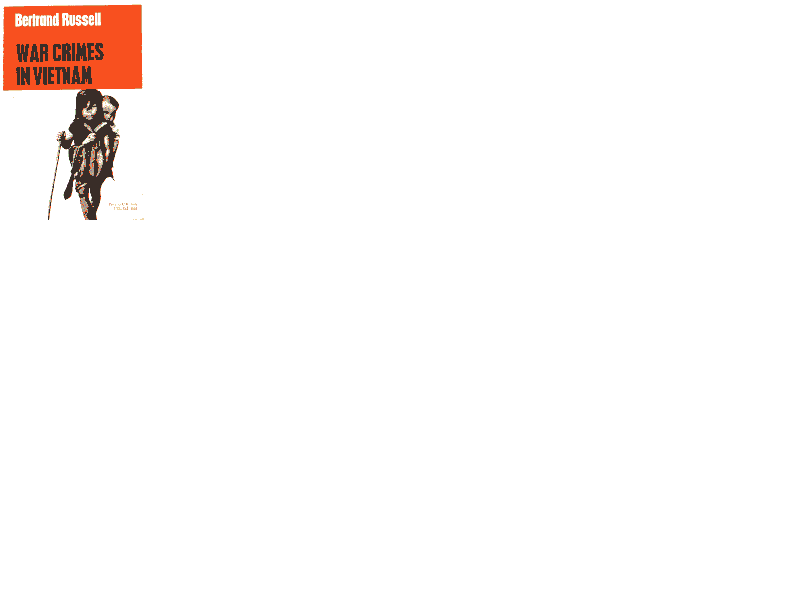
WAR CRIMES IN VIETNAM
2. WAR AND ATROCITY IN VIETNAM
2. WAR AND ATROCITY IN VIETNAM
Copyright Bertrand Russell Peace Foundation Ltd. - with permission
March 13, 1964

 |
2. WAR AND ATROCITY IN VIETNAM |  |
| 'Vietcong'. The United States has sought to slur the guerrilla movement by naming it the 'Vietcong'. 'Vietcong' means 'Vietnamese Commies'. No group in South Vietnam refers to itself by that abbreviated name. Those who chose that name for the guerrillas ignored something very important. They relied on the fact that in the USA the term 'Communist' is enough to alarm the public and to smear any movement, and never realized until too late what favourable Connotations 'Communist' has elsewhere. The US has, by its own intended slander, reinforced the good image Communists have had in South-East Asia through associating Communism with movements for national liberation, and movements of the people for independence and social justice. It is ironic that when the us realized its grave blunder, it sought to rectify the situation by renaming the liberators. As reported in the New York Times on June 5, 1962, the United States Information Agency sponsored a contest 'for a new name for the Vietcong guerrillas', admitting that it didn't think 'communist is the type of a name to inspire hatred among the country's illiterate masses'. It offered a cash prize for a 'colloquial peasant term implying disgust or ridicule.' In South Vietnam, the only names which meet that test are 'French' and 'American'. |
'One day', she says, 'I came home and there were two security agents waiting for me. I was taken to the town of Faifo and for months on end I was tortured very badly . . . Once I recovered consciousness and found I was stark naked, blood oozing from wounds all over my body. There were others in the cell. I heard a woman moaning, and in the half dark saw a woman in a pool of blood. She had been beaten into having a miscarriage. Then I made out an old man. An eye had been gouged out and he was dying. Alongside him was a thirteen- or fourteen-year-old boy, also dead; a little further away, another dead youth with his head split open. They had thrown me there, hoping the sight of this would break me down.'Finally, she was covertly conveyed to North Vietnam. This story was subsequently confirmed by neutral enquirers. It is typical of many among the 350,000 political prisoners.
| National Liberation Front. In this common front, all those forces combined who had suffered and decided on armed self-defence. It constitutes an organization of many segments of the population. Communists and non-Communists alike were victims of Diem's regime; they united in self-defence. Much of the leadership comes from the intellectuals, who felt the lack of freedom most severely; doctors, lawyers, and university professors play prominent roles in the Committees of the National Liberation Front. Many religious leaders were instrumental in the organizing of the Front. They represent the majority (Buddhists) and the minorities (some Roman Catholics and many ethnic minorities whose unique ways of life were intolerable to the bigot, Ngo Dinh Diem) of South Vietnam's worshippers. Small businessmen and even progressive landlords joined peasant farmers, fishermen, and workers to help form the Front against the common enemy and oppressor. |
'The rounding up of the entire rural population in strategic hamlets, the burning of all abandoned villages with the grain and possessions of the inhabitants and the "locking" of strategic villages behind barbed wire.'
It is clear that the majority of the inhabitants wish their country to be neutral. This the American Government cannot tolerate. The euphemisms used for the military operations which have belatedly been acknowledged to be the full responsibility of the United States are instructive. 'Operation Sunrise', 'Pacification of the West' and 'Morning Star' resulted, in the area attacked, in the destruction of all villages, fields and crops. In 1962 alone, according to General Paul D. Harkins, 30,000 peasants were killed. The Christian Science Monitor described this process on March 8, 1963:'Since the army finds sullen villagers and does not know which are pro-Communist and which are merely dissatisfied with Saigon, and since the army must do its job, it shoots anyone seen running or looking dangerous. It often shoots the wrong peasants. They are in the records of battle listed as Communists. Anyone killed is automatically a Vietcong.'On January 25, 1963, Life had photos of napalm bombings with the following caption:'Swooping low across enemy infested land, US pilot instructors watch Vietnamese napalm strike. The object of the fire bombing is to sear all foliage and to flush the enemy into the open.''The New York Times also reported that us advisers made a tally of guerrilla corpses after each battle to make sure that Diem's troops were using American equipment to maximum advantage, so that they could display a good "bag".' (Militant, April '5, 1963.)In the light of all this evidence, it is strange to find the New York Times saying on April 8, 1963:'Napalm has been used by the South Vietnam Air Force and has certainly killed innocent people, as other weapons have done in all wars. American [my emphasis] advisers have opposed its employment on both moral and practical grounds against all except clearly identified military targets.'This definition appears to include sixty per cent of the villages, hospitals and clinics and all peasants who run or look dangerous. This editorial reply contradicts the New York Times' own news reports about American use and insistence upon the use of napalm and other weapons on non-military areas.
Many people in the Pentagon are urging that the war should be extended to an invasion of North Vietnam. President Johnson has announced that those countries which are directing and supplying the (so-called) Communist guerrillas in South Vietnam are .playing a deeply dangerous game. A map in the New York Times of April I, 1962, shows the forces of the Liberation Front in the far South around Saigon, and nowhere near the borders of Laos or North Vietnam. Both British and American reporters have stated that primitive guerrilla weapons have been used by the 'Vietcong', in addition to those plentiful supplies captured from the forces of the nominal government of South Vietnam. The London Times of February 24 has stated that it is now considered doubtful whether the Government of South Vietnam has any will to win the war. The Observer of March 1, 1964, quoted an American official as stating that the trouble lay in the fact that, while the United States wished to extend the war, the Vietnamese only wanted to end the war.
The situation which faces those who have conducted this war is grave. Should the United States retire and allow victory to the NLF? Should America engage in a naked war of conquest, which will be clearly seen as such, and attempt to establish again a Government dependent entirely upon alien armed force? This 'enemy' controls nearly seventy per cent of South Vietnam. The majority of the NLF was described as non-Communist by former Premier Tran Van Huu in Paris, as reported in the Observer. The 'Vietcong' official policy asks for a neutral and disengaged South Vietnam. Despite all the attempts on the part of the Western press to describe this war as one in which a helpless democratic people is under ruthless attack from an aggressive Communist neighbour, it is evident that the NLF is a popular front which has fought an appalling tyranny in South Vietnam and has been opposed by the United States at an incalculable cost to the population. Why is this non-Communist, neutralist, popular front so ruthlessly opposed? Even the Communist North has declared, through Ho Chi Minh, that it wishes to be unified with the South on terms of neutrality in the Cold War and independence of Russia, China and the West (The Times, 5 November, 1963).
The policy of the United States which has led to the prospect of an American invasion of North Vietnam will likely bring on Chinese involvement, with war with China as the result. The Soviet Union would then be drawn in There are few parallels with the war in Vietnam. It has lasted nearly two decades; two Western industrial powers of overwhelming might have fought peasant guerrillas in a manner reminiscent of the Japanese during the Second World War. Everything short of nuclear weapons has been employed. Atrocity has characterized the conduct of the war throughout its history. The Western press has hesitatingly discovered some of the facts about this war during the last two years. The Western peace movement has been conspicuously silent or restrained in its setting out of the truth about the war. The war has had no purpose Its extension will bring direct conflict between the Cold War powers, with the possible destruction of mankind as the culmination of this folly. The tragedy in Vietnam indicates the extent to which it is possible to hide or disguise terrible crimes and it is time that people in the West raised their voices for an end to the bloodshed.
Click here for Appendix to 'War Crimes in Vietnam': Report by Ralph Schoenman
Click for US Vietnam war crimes overview page
Or click here for index to whole website
Scanning, HTML Rae West. First uploaded 98-08-17. Put back 2013-01-09<